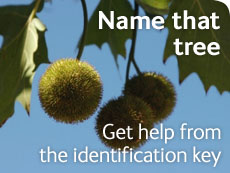Evergreen oak
Also holm oak
Quercus ilex
ID check
- Leaves are alternate in arrangement, not divided into leaflets and are evergreen.
- Leaves have spiny edges and are white or green-felted on the underside.
- The fruit is an acorn. The flowers are green - the males are in slender catkins.
Description
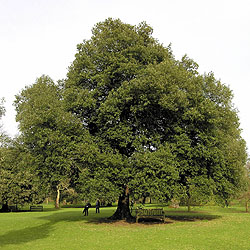
Evergreen oak © Andrea Moro
Tree
Up to 25m tall with a broadly domed crown.
Twigs
Grey-brown and hairy.
Leaves
They are 3-7cm long, thick and leathery but not stiff. They are glossy green on the upper side and felted with hairs on the underside. The edges are wavy, with short spiny teeth in mature trees - though the spines are often absent in young growth.
Fruit
The acorn is seated in a cup 12mm in diameter and made up of close-pressed scales, thickly covered with white hairs.
Images
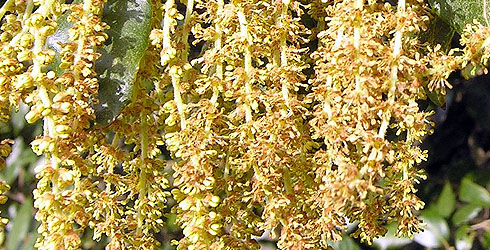
Male evergreen oak flowers are in slender catkins.
© Università di Trieste, Dipartimento di Biologia. Photo: Andrea Moro
Evergreen oak leaves.
© Università di Trieste, Dipartimento di Biologia. Photo: Andrea Moro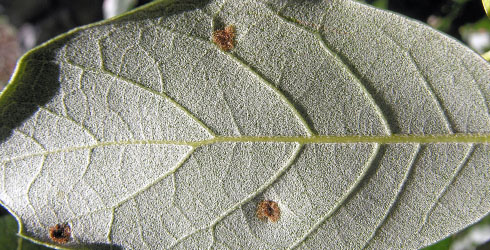
Evergreen oak leaves.
© Bob Press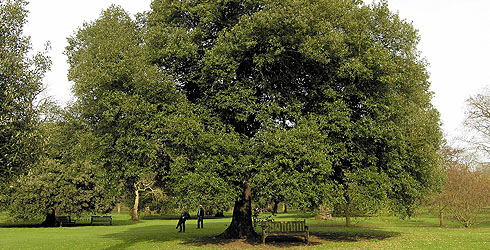
Evergreen oak tree.
© Andrea MoroDiagrams
These diagrams explain some of the important tree and plant parts.
Flower

Leaf parts
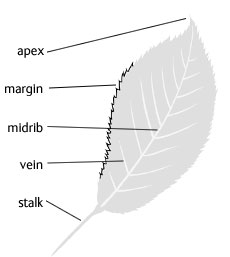
Leaf shapes
These diagrams show the different leaf shapes you might come across on your survey. Leaf shapes are important for identifying trees.
Palmate leaf
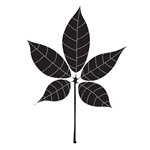
Palmately lobed leaf
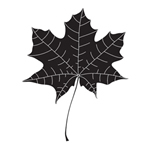
Pinnate leaf
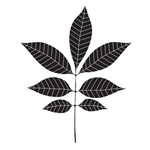
Pinnately lobed leaf

Leaf arrangements
The way leaves are arranged on a stem can be important for identifying trees.
Opposite leaves
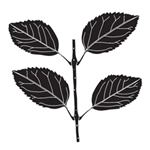
Alternate leaves
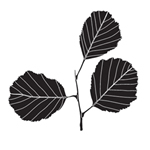
Glossary
These definitions explain some of the trickier words and phrases used in these pages.
Alternate – the arrangement of leaves on a stem - the leaves attach at different but alternating points, rather than opposite points.
Anther – the part of the stamen that contains pollen.
Apex – the top or end; the tip of a leaf for example.
Bract – a leaf-like structure, usually found below the flower or fruit.
Bud scale – usually a type of modified leaf that encloses and protects a bud.
Catkin – slender inflorescences made up of small flowers, usually reduced to the male and female parts. Catkins are typical of wind-pollinated trees.
Coniferous – trees that have cones, and needle or scale-like leaves.
Crown – in a tree, everything above the trunk.
Deciduous – a tree that sheds its leaves all at once in the autumn.
Evergreen – a tree that retains its leaves all year round.
Girth – the circumference of something, like the trunk of a tree.
Gland (of a leaf) – a small organ on a leaf that gives out oils or similar substances.
Inflorescence – the arrangement of all the flowers on a tree. The shape is used to help identify the plant.
Key – a tool used to identify groups and species of living things.
Leaflet – a subdivision of a leaf - it may look like a leaf but is attached to the leaf stalk or midrib, not to the shoot.
Lobe – a rounded or pointed section of a leaf, not divided into a leaflet.
Margin – the edge of a leaf.
Midrib – the central vein of a leaf.
Native – a tree that occurs naturally in an area, as opposed to a non-native tree that has been introduced.
Opposite – the arrangement of leaves on a stem - the leaves attach in pairs at the same point, opposite each other, rather than attaching at alternate points.
Palmate – a leaf shape in which the lobes or leaflets radiate from a single point, like fingers from a hand.
Petals – usually larger and more brightly coloured than sepals.
Pinnate – a leaf shape in which the lobes or leaflets are arranged on both sides of the stalk or midrib like a feather.
Pollarded – when the upper branches of a tree have been cut back to encourage new growth.
Sepals – the outermost parts of a flower which cover and protect the flower when it is in bud. They are usually green.
Side shoots – short, spur-like shoots growing from the main shoots.
Spike – an elongated cluster of flowers; a type of inflorescence.
Stalk – the structure that supports the blade of a leaf.
Stigma – the part at the end of the style. It is covered with a sticky substance that pollen adheres to.
Stipule – a small, leaf-like structure, found where the leaf connects to the stem.
Style – a tube-like structure in the centre of a flower that supports the stigma.
Trunk – the woody stem of a tree, before the branches.
Urban forest – the trees in our towns and cities.
Whorl – 3 or more leaves or needles circling around a stem.

